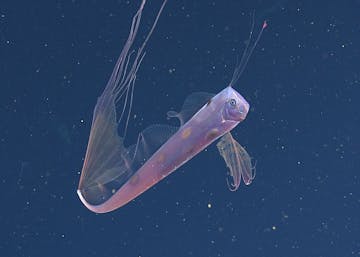Whalefishes (family Cetomimidae) have rarely been collected alive, so much of their biology remains a mystery. Most research on these fishes has been based on specimens collected by deep-water trawl nets. Observations from MBARI’s ROVs provide valuable insight into their natural history. This whalefish MBARI researchers observed in July 2021 had a swollen stomach indicating that it had the recent fortune to gulp in a large fish as prey. Video: © 2021 MBARI
Out of the darkness of the ocean’s midnight zone, MBARI’s ROV Doc Ricketts spotted a billowing crimson curtain. Moving in for a closer look, the submersible’s lights revealed the giant phantom jelly (Stygiomedusa gigantea). MBARI’s ROVs have logged thousands of dives, yet we have only seen this spectacular species nine times. Video: © 2021 MBARI
During a dive with our education and conservation partner, the Monterey Bay Aquarium, the team came across a rare treat: a barreleye fish (Macropinna microstoma). Aquarist Tommy Knowles and his team were aboard MBARI’s R/V Rachel Carson with our ROV Ventana to collect jellies and comb jellies for the Aquarium’s upcoming Into the Deep exhibition when they spotted this fascinating fish. The team stopped to marvel at Macropinna before it swam away. Video: © 2021 MBARI

In December 2021, MBARI’s Midwater Ecology Group spotted a pair of juvenile king-of-the-salmon (Trachipterus altivelis). We rarely see these unusual ribbonfish, so each encounter helps us gain a better understanding of this mysterious animal. Our encounters with seldom-seen deep-sea animals add to our efforts to establish a baseline for deep-sea biodiversity, a critical step toward our mission of understanding a changing ocean. Image: © 2021 MBARI

